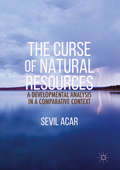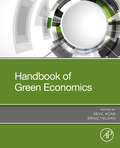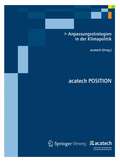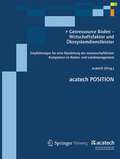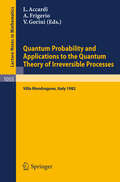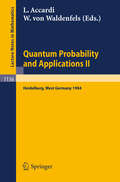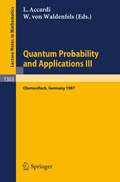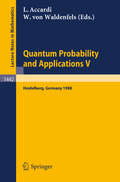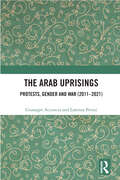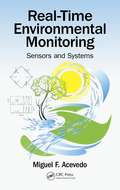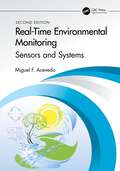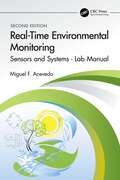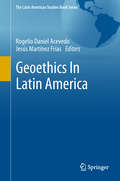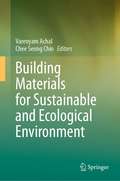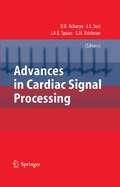- Table View
- List View
The Curse of Natural Resources: A Developmental Analysis in a Comparative Context
by Sevil AcarThis book examines the paradox that resource-rich countries often struggle to manage their resources in a way that will help their economies thrive. It looks at how a country's political regime and quality of governance can determine the degree to which it benefits - or suffers - from having natural resources, shifting away from the traditional focus on economic growth data to study the complex implications of these resources for human well-being and sustainable development. To this end, Acar examines a panel of countries in terms of the effects of their natural resources on human development and genuine saving, which is a sustainability indicator that takes into account the welfare of future generations by incorporating the changes in different kinds of capital. Acar finds that the exportation of agricultural raw materials is associated with significant deterioration in human development, while extractive resource exports, such as energy and minerals, have negative implications for genuine savings. Next, the book compares the development path of Norway before and after discovering oil, contrasting it with Sweden's development. The two countries, which followed almost identical paths until the 1970s, diverged significantly in terms of per capita income after Norway found oil.
Handbook of Green Economics
by Sevil Acar Erinç YeldanHandbook of Green Economics reveals the breadth and depth of advanced research on sustainability and growth, also identifying opportunities for future developments. Through its multidimensional examination, it demonstrates how overarching concepts, such as green growth, low carbon economy, circular economy and others work together. Some chapters reflect on different discourses on the green economy, including pro-growth perspectives and transformative approaches that entail de-growth. Others argue that green policies can spark economic innovation, particularly in developing and emerging market economies. Part literature summary, part analysis and part argument, this book shows how the right conditions can stimulate economic growth while achieving environmental sustainability. This book will be a valuable resource for graduate students and academic researchers whose focus is on the green economy. With an increasing interest in the topic among researchers and policymakers, users will find different theoretical perspectives and explore policy implications in this growing subject area.Covers the failures of the past, the challenges of the present, and the opportunities of the futureSurveys 10 aspects of the green economy, including conceptualization, natural capital, poverty and inequality, welfare, and financeEmphasizes the theoretical and empirical aspects of greening approaches that are policy-relevant
Anpassungsstrategien in der Klimapolitik (acatech POSITION)
by AcatechEine effektive Klimapolitik muss nicht nur unerwünschten Klimawandel vermeiden, sondern auch Anpassungsstrategien umfassen. Diese sollen die negativen Auswirkungen von Klimaveränderungen für Wirtschaft und Gesellschaft mindern. Die Entwicklung neuer Technologien, die weltweit einen Beitrag zur Anpassung an den Klimawandel leisten können, bietet auch wirtschaftliche Chancen für deutsche Unternehmen. Diese acatech POSITION stellt spezifische Klimafolgen in sechs Schlüsselbereichen dar, darunter natürliche Ressourcen, Stadtentwicklung, Energie- und Gesundheitsversorgung. So wird ein Beitrag zur gegenwärtigen Anpassungsdiskussion geleistet. acatech möchte sowohl die Risiken als auch die Chancen der Folgen des Klimawandels in Deutschland aufzeigen, das Bewusstsein für die Bedeutung von Anpassungsmaßnahmen in der gesellschaftlichen Diskussion stärken und mit seinen Handlungsempfehlungen zur Entwicklung nachhaltiger Anpassungsstrategien beitragen.
Georessource Boden – Wirtschaftsfaktor und Ökosystemdienstleister: Empfehlungen für eine Bündelung der wissenschaftlichen Kompetenz im Boden- und Landmanagement (acatech POSITION)
by AcatechBöden bilden eine wesentliche Lebensgrundlage der Menschen. Auf ihnen wachsen Pflanzen, die als Nahrungs- und Futtermittel dienen oder als Biomasse, aus der etwa Energie gewonnen wird. Sie erfüllen auch wichtige Funktionen in unserem Ökosystem und sind als Ausgangspunkt aller biobasierten Wertschöpfungsketten ein zentraler Wirtschaftsfaktor. Der Klimawandel beeinträchtigt sowohl die Produktions- als auch Ökosystemfunktionen des Bodens. Diesen Herausforderungen muss auch die Forschung zum Boden- und Landmanagement begegnen. Die acatech POSITION erklärt, warum die deutsche Bodenforschung fächerübergreifend zusammenarbeiten sollte und benennt elf notwendige und neue Aktionsfelder dafür. acatech gibt Empfehlungen, wie die Bündelung der wissenschaftlichen Kompetenz gelingt und die Bodenfunktionen erhalten werden.
Quantum Probability and Applications to the Quantum Theory of Irreversible Processes: Proceedings of the International Workshop held at Villa Mondragone, Italy, September 6-11, 1982 (Lecture Notes in Mathematics #1055)
by L. Accardi A. Frigerio V. GoriniQuantum Probability and Applications II: Proceedings of a Workshop held in Heidelberg, West Germany, October 1-5, 1984 (Lecture Notes in Mathematics #1136)
by Luigi Accardi Wilhelm V. WaldenfelsQuantum Probability and Applications III: Proceedings of a Conference held in Oberwolfach, FRG, January 25-31, 1987 (Lecture Notes in Mathematics #1303)
by Luigi Accardi Wilhelm V. WaldenfelsThese proceedings of the first Quantum Probability meeting held in Oberwolfach is the fourth in a series begun with the 1982 meeting of Mondragone and continued in Heidelberg ('84) and in Leuven ('85). The main topics discussed were: quantum stochastic calculus, mathematical models of quantum noise and their applications to quantum optics, the quantum Feynman-Kac formula, quantum probability and models of quantum statistical mechanics, the notion of conditioning in quantum probability and related problems (dilations, quantum Markov processes), quantum central limit theorems. With the exception of Kümmerer's review article on Quantum Markov Processes, all contributions are original research papers.
Quantum Probability and Applications V: Proceedings of the Fourth Workshop, held in Heidelberg, FRG, Sept. 26-30, 1988 (Lecture Notes in Mathematics #1442)
by Luigi Accardi Wilhelm V. WaldenfelsThese proceedings of the workshop on quantum probability held in Heidelberg, September 26-30, 1988 contains a representative selection of research articles on quantum stochastic processes, quantum stochastic calculus, quantum noise, geometry, quantum probability, quantum central limit theorems and quantum statistical mechanics.
The Arab Uprisings: Protests, Gender and War (2011-2021)
by Giuseppe Acconcia Lorenza PeriniThis book investigates the role of social groups in mobilizing resources for protests in repressive contexts. In particular, it examines the impact of organizations and informal groups on individual engagement in the protests developed in 2010–2011 in Tunisia, Egypt, and Syria. Empirical analysis draws on a wave of events and protests that took place between 2010 and 2021. It explores how, in repressive contexts, spontaneous groups and more established and formal organizations continuously switch from one form to another, transforming themselves faster than they would do in democratic contexts.
The Arab Uprisings: Protests, Gender and War (2011-2021)
by Giuseppe Acconcia Lorenza PeriniThis book investigates the role of social groups in mobilizing resources for protests in repressive contexts. In particular, it examines the impact of organizations and informal groups on individual engagement in the protests developed in 2010–2011 in Tunisia, Egypt, and Syria. Empirical analysis draws on a wave of events and protests that took place between 2010 and 2021. It explores how, in repressive contexts, spontaneous groups and more established and formal organizations continuously switch from one form to another, transforming themselves faster than they would do in democratic contexts.
Real-Time Environmental Monitoring: Sensors and Systems
by Miguel F. AcevedoThe natural environment is complex and changes continuously at varying paces. Many, like the weather, we notice from day to day. However, patterns and rhythms examined over time give us the bigger picture. These weather statistics become climate and help us build an understanding of the patterns of change over the long term. Real-Time Environmental Monitoring: Sensors and Systems introduces the fundamentals of environmental monitoring, based on electronic sensors, instruments, and systems that allow real-time and long-term data acquisition, data-logging, and telemetry. The book details state-of-the-art technology, using a practical approach, and includes applications to many environmental and ecological systems. In the first part of the book, the author develops a story of how starting with sensors, you can progressively build more complex instruments, leading to entire systems that end with databases and web servers. In the second part, he covers a variety of sensors and systems employed to measure environmental variables in air, water, soils, vegetation canopies, and wildlife observation and tracking. This is an emerging area that is very important to some aspects of environmental assessment and compliance monitoring. Real-time monitoring approaches can facilitate the cost effective collection of data over time and, to some extent, negate the need for sample, collection, handling, and transport to a laboratory, either on-site or off-site. It provides the tools you need to develop, employ, and maintain environmental monitors.
Real-Time Environmental Monitoring: Sensors and Systems - Textbook
by Miguel F. AcevedoWritten 10 years after the publication of the first edition, this updated edition of Real-Time Environmental Monitoring: Sensors and Systems introduces the fundamentals of environmental monitoring based on electronic sensors, instruments, systems, and software that allow continuous and long-term ecological and environmental data collection. It accomplishes two objectives: explains how to use sensors for building more complex instruments, systems, and databases, and introduces a variety of sensors and systems employed to measure environmental variables in air, water, soils, vegetation canopies, and wildlife observation and tracking. This second edition is thoroughly updated in every aspect of technology and data, and each theoretical chapter is taught parallel with a hands-on application lab manual. Emphasizes real-time monitoring as an emerging area for environmental assessment and compliance and covers the fundamentals on how to develop sensors and systems Presents several entirely new topics not featured in the first edition, including remote sensing and GIS, machine learning, weather radar and satellites, groundwater monitoring, spatial analysis, and habitat monitoring Includes applications to many environmental and ecological systems Uses a practical, hands-on approach with the addition of an accompanying lab manual, which students can use to deepen their understanding, based on the author’s 40 years of academic experience Intended for upper-level undergraduate and graduate students, taking courses in civil and environmental engineering, electrical engineering, mechanical engineering, geosciences, and environmental sciences, as well as professionals working in environmental services, and researchers and academics in engineering.
Real-Time Environmental Monitoring: Sensors and Systems - Textbook
by Miguel F. AcevedoWritten 10 years after the publication of the first edition, this updated edition of Real-Time Environmental Monitoring: Sensors and Systems introduces the fundamentals of environmental monitoring based on electronic sensors, instruments, systems, and software that allow continuous and long-term ecological and environmental data collection. It accomplishes two objectives: explains how to use sensors for building more complex instruments, systems, and databases, and introduces a variety of sensors and systems employed to measure environmental variables in air, water, soils, vegetation canopies, and wildlife observation and tracking. This second edition is thoroughly updated in every aspect of technology and data, and each theoretical chapter is taught parallel with a hands-on application lab manual. Emphasizes real-time monitoring as an emerging area for environmental assessment and compliance and covers the fundamentals on how to develop sensors and systems Presents several entirely new topics not featured in the first edition, including remote sensing and GIS, machine learning, weather radar and satellites, groundwater monitoring, spatial analysis, and habitat monitoring Includes applications to many environmental and ecological systems Uses a practical, hands-on approach with the addition of an accompanying lab manual, which students can use to deepen their understanding, based on the author’s 40 years of academic experience Intended for upper-level undergraduate and graduate students, taking courses in civil and environmental engineering, electrical engineering, mechanical engineering, geosciences, and environmental sciences, as well as professionals working in environmental services, and researchers and academics in engineering.
Real-Time Environmental Monitoring: Sensors and Systems - Lab Manual
by Miguel F. AcevedoThis lab manual is a companion to the second edition of the textbook Real-Time Environmental Monitoring: Sensors and Systems. Tested in pedagogical settings by the author for many years, it includes applications with state-of-the-art sensor technology and programs such as R, Python, Arduino, PHP, HTML, and SQL. It helps students and instructors in science and engineering better understand how to use and design a variety of sensors, and how to build systems and databases when monitoring different environments such as soil, water, and air. Examples of low-cost and open-access systems are included and can serve as the basis of learning tools for the concepts and techniques described in the textbook. Furthermore, the manual provides links to websites and scripts in R that allow learning how to analyze a variety of datasets available from repositories and databases maintained by many agencies and institutions. The first hands-on environmental monitoring lab manual written in tutorial style and classroom tested. Includes 14 lab guides that parallel the theory developed in 14 chapters in the companion textbook. Provides clear step-by-step protocols to understand basic and advanced theory through applicable exercises and problems. Injects a practical implementation of the existing textbook. A valuable guide for students and practitioners worldwide engaged in efforts to develop, employ, and maintain environmental monitors. Intended for upper-level undergraduate and graduate students taking courses in electrical engineering, civil and environmental engineering, mechanical engineering, geosciences, and environmental sciences, as well as instructors who teach these courses. Professionals working in fields such as environmental services, and researchers and academics in engineering will also benefit from the range of topics included in this lab manual.
Real-Time Environmental Monitoring: Sensors and Systems - Lab Manual
by Miguel F. AcevedoThis lab manual is a companion to the second edition of the textbook Real-Time Environmental Monitoring: Sensors and Systems. Tested in pedagogical settings by the author for many years, it includes applications with state-of-the-art sensor technology and programs such as R, Python, Arduino, PHP, HTML, and SQL. It helps students and instructors in science and engineering better understand how to use and design a variety of sensors, and how to build systems and databases when monitoring different environments such as soil, water, and air. Examples of low-cost and open-access systems are included and can serve as the basis of learning tools for the concepts and techniques described in the textbook. Furthermore, the manual provides links to websites and scripts in R that allow learning how to analyze a variety of datasets available from repositories and databases maintained by many agencies and institutions. The first hands-on environmental monitoring lab manual written in tutorial style and classroom tested. Includes 14 lab guides that parallel the theory developed in 14 chapters in the companion textbook. Provides clear step-by-step protocols to understand basic and advanced theory through applicable exercises and problems. Injects a practical implementation of the existing textbook. A valuable guide for students and practitioners worldwide engaged in efforts to develop, employ, and maintain environmental monitors. Intended for upper-level undergraduate and graduate students taking courses in electrical engineering, civil and environmental engineering, mechanical engineering, geosciences, and environmental sciences, as well as instructors who teach these courses. Professionals working in fields such as environmental services, and researchers and academics in engineering will also benefit from the range of topics included in this lab manual.
Simulation of Ecological and Environmental Models
by Miguel F. AcevedoGiven the importance of interdisciplinary work in sustainability, Simulation of Ecological and Environmental Models introduces the theory and practice of modeling and simulation as applied in a variety of disciplines that deal with earth systems, the environment, ecology, and human-nature interactions. Based on the author's many years of teaching g
Simulation of Ecological and Environmental Models
by Miguel F. AcevedoGiven the importance of interdisciplinary work in sustainability, Simulation of Ecological and Environmental Models introduces the theory and practice of modeling and simulation as applied in a variety of disciplines that deal with earth systems, the environment, ecology, and human-nature interactions. Based on the author's many years of teaching g
Geological Records of the Fuegian Andes Deformed Complex Framed in a Patagonian Orogenic Belt Regional Context (SpringerBriefs in Earth System Sciences)
by Rogelio Daniel AcevedoThis book studies the Fuegian Andes in Argentina, showing both simple and complex aspects. The first ones refer to the general stratigraphy of the area and the latter result from their tectonic characteristics. Concerning the stratigraphy, an appraisal of the denomination and valorization of formations of Jurassic and early Cretaceous age is performed here to reach the simple scheme of the Fuegian-Patagonian continuity under the name of “Fuegian Andes Deformed Complex”. As an essay the formational nomenclature is simplified and the local concept of basement is evaluated. In relation to their structural aspects it is assumed that the formation of the orogenic Fuegian arc and the folding of the Mesozoic and early Tertiary layers are connected phenomena. Tectonic forces from the West, the Northeast and the South have had participation in the formation of the tectonic arc. The lithostatic column pressure was added once the layers were folded and thrusted upwards during the birth of the Fuegian Andes. Even the speculation of a great main fold overturned to North, as an abstraction, is considered. Instead, the Magallanes-Fagnano fault is appreciated only as a product of the transcurrent Quaternary movements, lacking associated eruptive processes that contribute to define plate borders.
Geological Resources of Tierra del Fuego (Springer Geology)
by Rogelio Daniel AcevedoThe CADIC’s Geological Resources Program will soon turn 40 years of fruitful development. During this period many projects were carried out and others remain to be implemented. In the course of time three generations of researchers have been formed. Mentioning names would be unfair to those that could be involuntarily omitted. There is still a long way to go. The eagerness for knowledge should not stop. This book is a tribute to all those people who have worked in the different projects of pure and applied science, and educational, and human resources training, granted to this founding program and associated laboratories of the regional center of CONICET in Ushuaia, Tierra del Fuego, Argentina. The twenty papers which constitute this book have a genuine Latin appeal, having been written by 50 authors based in Argentina and Spain. All this contributions are concerned with Fuegian geological resources. Everyone concerned with this work hopes that it will prove a fitting and lasting memorial to Nacho Subías, whose personal contribution to our knowledge of this geology was outstanding.
Geoethics In Latin America (The Latin American Studies Book Series)
by Rogelio Daniel Acevedo Jesús Martínez FríasThis book studies geoethics in Latin America and offers comprehensive research on geoethics and geoeducation. Its respective chapters explore geoethics in relation to UNESCO geoparks, mining activities in Latin America, natural hazards and risk management. Geoethics is a key discipline in the field of Earth and Planetary Sciences, and not only includes scientific, technological, methodological and social-cultural aspects, but also addresses the need to consider appropriate protocols, scientific integrity issues and a code of good practice when studying the abiotic world.The position of Latin America’s recently created geoethics associations is based on protection of the environment, together with a reassurance that the balance of nature and the rights of human beings to enjoy it will be preserved.
Impact Craters in South America (SpringerBriefs in Earth System Sciences)
by Rogelio Daniel Acevedo Maximiliano C. Rocca Juan Federico Ponce Sergio G. StincoA complete and updated catalogue of impact craters and structures in South America from 2014 is presented here. Approximately eighty proven, suspected and disproven structures have been identified by several sources in this continent. All the impact sites of this large continent have been exhaustively reviewed: the proved ones, the possible ones and some very doubtful. Many sites remain without a clear geological "in situ" confirmation and some of them could be even rejected. Argentina and Brazil are leading the list containing almost everything detected. In Bolivia, Chile, Colombia, Guyana, Paraguay, Perú, Uruguay and Venezuela only a few were observed. Only Ecuador is waiting for new discoveries. So far, the largest well stated impact site is still the Araguainha structure in Brazil with its 40 kilometers in diameter. However, two possible impact structures are larger than Araguainha: Malvinas, (with 250 kilometers in diameter) and Vichada in Colombia, (50 kilometers). This study also reports the existence of some Tertiary-Quaternary glassy impactite layers: the "escorias" and "tierras cocidas" of the pampas in Argentina.
Catalogue of Meteorites from South America (SpringerBriefs in Earth System Sciences)
by Rogelio Daniel Acevedo Maximiliano C.L. Rocca Víctor Manuel GarcíaThe first Catalogue of Meteorites from South America includes new specimens never previously reported, while doubtful cases and pseudometeorites have been deliberately omitted.The falling of these objects is a random event, but the sites where old meteorites are found tend to be focused in certain areas, e.g. in the deflation surfaces in Chile’s Atacama Desert, due to favorable climate conditions and ablation processes.Our Catalogue provides basic information on each specimen like its provenance and the place where it was discovered (in geographic co-ordinates and with illustrative maps), its official name, its classification type (class, and if applicable, weathering grade and shock stage), if it was seen falling or was found by chance, its total mass or weight, the institution where it is held, and the most important bibliographic references about it.
Ecological Processes at Marine Fronts: Oases in the ocean (SpringerBriefs in Environmental Science)
by Eduardo Marcelo Acha Alberto Piola Oscar Iribarne Hermes MianzanThis book reviews and summarizes the results and hypotheses raised by studies directly or indirectly dealing with the ecology of fronts and aims to identify the themes that connect them to produce a synthesis of this knowledge. Though not immediately perceived the ocean is highly structured and fronts are one of the most important components of its structural complexity. Marine fronts have been known since the early 20th Century, however, the more recent availability of high resolution satellite imagery, field measurements and numerical simulations have greatly advanced our understanding of their ecological impact. This work touches on topics such as front types, its biology and its comparisons with other bounderies at sea, as well as comparisons of fronts with terrestrial boundaries and the ‘ecotone’ concept. Furthermore, it also looks at the management and conservation of marine life.
Building Materials for Sustainable and Ecological Environment
by Varenyam Achal Chee Seong ChinThis book uses theories, hypotheses, policies, practical insights and case studies to introduce and elucidate green building materials for sustainable construction. Cement is the most widely used building material in construction; however, it is not sustainable, being responsible for 7% of global carbon dioxide emissions and consuming huge quantities of energy. In order to limit the ecological damage, sustainable building materials are needed. Ecosystems are a source of important lessons and models for transitioning the built environment onto a sustainable path that opens options for sustainable building material in construction. The book provides a guide for readers seeking knowledge on sustainable building materials with the potential to lower environmental impact by reducing CO2 emission throughout the building’s lifecycle. The book is motivated by recent rapid advances in sustainable building materials production, including green building materials made of industrial by-products and recycled wastes, earth materials, plant-based materials, microbial-based materials or supplementary cementitious materials, to reduce the environmental impacts of traditional building materials. Discussing the development and applications of various sustainable building materials, including related case studies, and addressing the environmental issue with a holistic and systematic approach that creates an ecology of construction for sustainability in infrastructures, it offers promising solutions to achieve renewable and sustainable building materials for the future.
Advances in Cardiac Signal Processing
by U. Rajendra AcharyaThis book provides a comprehensive review of progress in the acquisition and extraction of electrocardiogram signals. The coverage is extensive, from a review of filtering techniques to measurement of heart rate variability, to aortic pressure measurement, to strategies for assessing contractile effort of the left ventricle and more. The book concludes by assessing the future of cardiac signal processing, leading to next generation research which directly impact cardiac health care.
